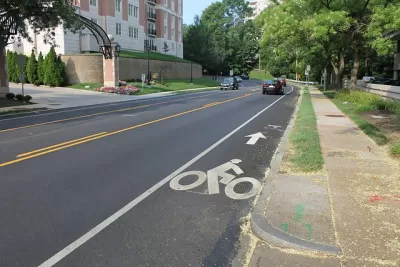The new form-based zoning code under consideration in the affluent Philadelphia suburb of Lower Merion "has something to teach Philadelphia and other big cities about how to organize density smartly," according to Inga Saffron.

Inga Saffron writes of the new zoning code in the Philadelphia suburb of Lower Merion as an example of the "conflicted soul of the suburbs"—that is, the conflict between a contemporary push for more inclusionary land use regulations with the status quo of politics ruled by residential property owners.
Lower Merion's new zoning code will face a final vote by the Board of Commissioners on September 18. "The rules," writes Saffron, "enshrine some of the most cherished — and exclusionary — features of 1950s suburbia. Big lots. Big houses. Big requirements for off-street parking. Affordable housing and sustainable construction barely rate a mention."
That seems like a full expression of the suburban status quo, but there is one visible sign of reform more in keeping with more recent planning trends: "Lower Merion is also going further than most of its peers to create pockets of density near transit and encourage walkability throughout the township," according to Saffron. Accessory Dwelling Units will also be legalized by the new code. Saffron notes that Philadelphia has only just begun to tackle that issue.
Lower Merio hired Elizabeth Plater-Zyberk, co-founder of the Congress for New Urbanism and Lower Merion native, to write the new zoning code. It follows, then, that Lower Merion's new code is of the form-based variety. Saffron explains:
Because Lower Merion was built around the Pennsylvania Railroad’s “Main Line,” it has always been a unique urban-suburban hybrid, with dense, transit-oriented villages like Ardmore and Bryn Mawr, and rolling country estates farther out in Gladwyne and Penn Valley that are totally car-dependent. The form-based code treats the two halves as different places, preserving the storybook version of the Main Line while still allowing density near the train stations.
The article includes insight from Plater-Zyberk about the city and the new code.
FULL STORY: Lower Merion’s new zoning code is a love letter to suburbia | Inga Saffron

Planetizen Federal Action Tracker
A weekly monitor of how Trump’s orders and actions are impacting planners and planning in America.

San Francisco's School District Spent $105M To Build Affordable Housing for Teachers — And That's Just the Beginning
SFUSD joins a growing list of school districts using their land holdings to address housing affordability challenges faced by their own employees.

The Tiny, Adorable $7,000 Car Turning Japan Onto EVs
The single seat Mibot charges from a regular plug as quickly as an iPad, and is about half the price of an average EV.

Seattle's Plan for Adopting Driverless Cars
Equity, safety, accessibility and affordability are front of mind as the city prepares for robotaxis and other autonomous vehicles.

As Trump Phases Out FEMA, Is It Time to Flee the Floodplains?
With less federal funding available for disaster relief efforts, the need to relocate at-risk communities is more urgent than ever.

With Protected Lanes, 460% More People Commute by Bike
For those needing more ammo, more data proving what we already knew is here.
Urban Design for Planners 1: Software Tools
This six-course series explores essential urban design concepts using open source software and equips planners with the tools they need to participate fully in the urban design process.
Planning for Universal Design
Learn the tools for implementing Universal Design in planning regulations.
Smith Gee Studio
City of Charlotte
City of Camden Redevelopment Agency
City of Astoria
Transportation Research & Education Center (TREC) at Portland State University
US High Speed Rail Association
City of Camden Redevelopment Agency
Municipality of Princeton (NJ)





























